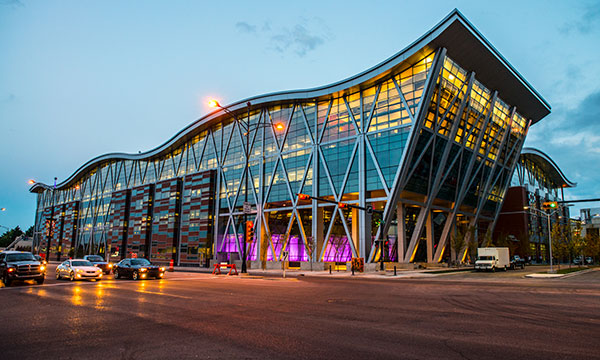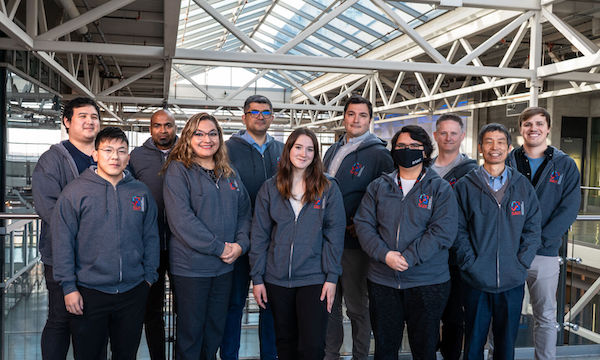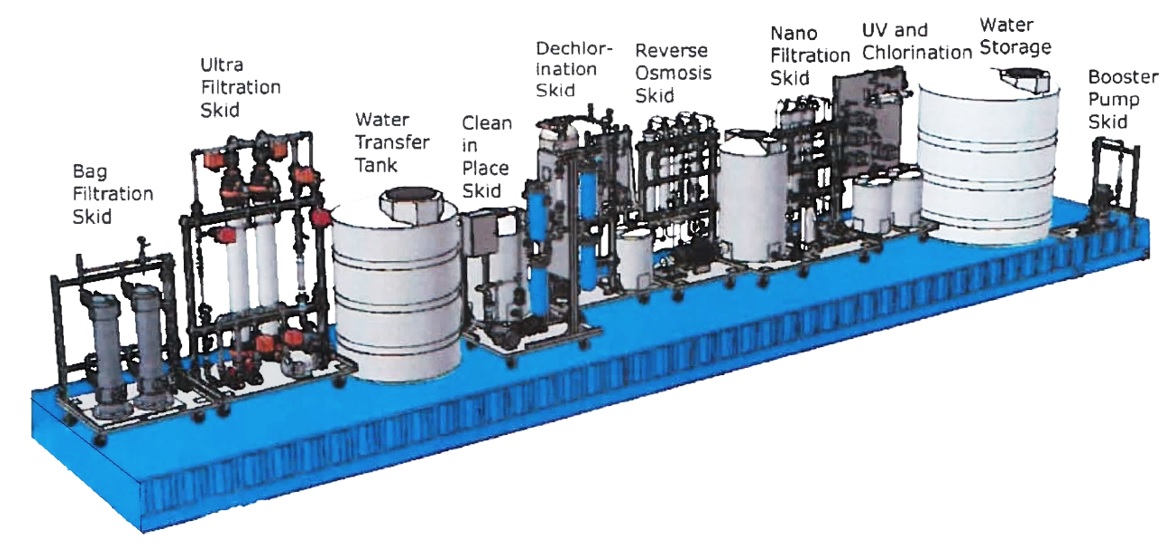Hybrid Water Desalination System Integration for Hydrogen Production
This applied research project is a partnership with Arrowhead Abandonments and involves upgrading and integrating a previously unused desalination system to meet pure water standards essential for electrolysis.

The Hybrid Water Desalination System (HWDS), initially designed for seawater desalination, has been transformed into a mobile, land-based solution capable of treating river water from the North Saskatchewan River. By integrating advanced technologies such as ultrafiltration (UF), reverse osmosis (RO), and nanofiltration (NF), the system now ensures high purity water production for hydrogen electrolyzers. To achieve this, Arrowhead Abandonments (AA) partnered with SAIT’s Centre for Energy Research and Clean Unconventional Technology Solutions (CERCUTS), one of the centres in the Applied Research and Innovation Services (ARIS) Hub.

In partnership with AA, CERCUTS played a pivotal role in optimizing the HWDS to achieve consistent pure water production, a critical input for electrolysis-based hydrogen generation. During the process, CERCUTS implemented energy recovery and advanced filtration technologies, which significantly helped reduce operational costs and enhance sustainability.
Water desalination is a crucial pre-treatment step for hydrogen production to ensure high purity water can be used for electrolysis. Desalination ensures salts and impurities are removed from the sea water, making it suitable for various industrial applications. The purified water then enters an electrolyzer, where electricity splits it into hydrogen (H₂) and oxygen (O₂). Since electrolysis requires ultra-pure water to prevent equipment damage and inefficiencies, desalination is essential — especially because seawater is too salty for direct use. By integrating renewable energy sources like solar or wind, water desalination enables a more sustainable approach to green hydrogen production, supporting clean energy initiatives and reducing environmental impact.
The collaboration between CERCUTS and Arrowhead Abandonments for water desalination is a strategic research partnership aimed at advancing water treatment innovation and technologies, particularly within Indigenous communities, and more broadly in Alberta and Canada. Portable and modular solutions, such as the Hybrid Water Desalination System (HWDS), will enable companies like Arrowhead to treat remote and rural water sources that are otherwise untreatable or costly to treat. The benefits of this project are expected to be far-reaching, as Arrowhead continues to develop and optimize the technology, upscale the HWDS for larger operational capacity, and deploy it in communities and for company operations to reduce reliance on existing freshwater sources. ARIS and CERCUTS are excited to continue this technology development journey with Arrowhead through further research.
Ehsan Aminfar
Research Chair, CERCUTSKey takeway
In 7 months, CERCUTS worked with AA to repurpose and optimize an existing HWDS to produce pure water for sustainable hydrogen production.
Membrane technology integration
New high-performance filtration membranes were procured and systematically installed and tested to verify the performance of the skid. This was to ensure the maximum possible treatment efficiency and TDS removal for any potential water source.
Combining UF, RO, and NF technologies to optimize the water treatment process, ensuring the removal of dissolved solids (TDS) down to 1-5 ppm.
Energy efficiency
Implemented an Energy Recovery Device (ERD) in the RO pump, reducing energy consumption and draw during treatment operations by repurposing pressure from concentrate streams.
Adjusted high-pressure pump RPMs to balance flow rates when testing variable concentrations in input streams and feeds.
Control infrastructure
Replaced key water quality sensors with upgraded models to ensure more accurate and consistent pH, electrical conductivity, and chlorine measurements during testing and operation.
The Programmable Logic Controller (PLC) was revised to enhance system automation, enabling predictive maintenance and adaptive optimization.
Expanded application scope
Performance testing ensured that the HWDS could be adapted to other water sources beyond seawater desalination and treatment. Other potential sources include brackish well water, river water, and industrial run-off.
HWDS project timeline
April — May 2024: Water resource assessment
Conducted comprehensive water quality analyses of river and well samples at SAIT’s analytical laboratories.
June — July 2024: HWDS system evaluation and upgrades
Identified and replaced faulty components, including filters and sensors. Cleaned and prepared system lines, tanks, and containers.
August — September 2024: System launch and optimization
Adjusted process parameters for RO and NF systems, ensuring optimal recovery rates and water quality. Successfully produced pure water with electrical conductivity between 2 and 10 µS/cm.
October — November 2024: Performance validation
Conducted on-site testing to monitor key metrics such as TDS, EC, turbidity, and total organic carbon (TOC). Confirmed alignment with hydrogen production requirements.
Upcoming developments
This project lays the groundwork for integrating hydrogen electrolyzers with enhanced HWDS. Subsequent phases will focus on:
- Developing the next project to design an ultrapure water skid
- Expanding system salability for larger hydrogen production units
- Exploring further energy-saving technologies
- Developing solutions for hydrogen storage in abandoned wells
About Arrowhead Abandonments
Arrowhead Abandonments is a First Nations-owned company specializing in oilfield abandonment projects. Founded in 2018, it operates with a mission to promote Indigenous employment and sustainable practices. With its offices across Saskatchewan and Alberta, AA leverages its expertise in engineering and downhole tools to support innovative energy solutions.
Thanks to the Team
- Dr. Ehsan Aminfar, Research Chair, CERCUTS
- Dawson Bachand, Operations Lead, CERCUTS
- Rogelio Lozano, OTSG Operations Lead, CERCUTS
- Molood Barmala, Senior Water Scientist, CERCUTS
- Mojtaba Karimian, Senior Process Specialist, CERCUTS
- Lifeng Zhao, Technologist, CERCUTS
- Matt LaPrairie, Lab Supervisor, CERCUTS
- Paige Humphrey, Chemical Technologist, CERCUTS

Centre for Energy Research and Clean Unconventional Technology Solutions
Our mission is to harness the power of green energy initiatives and sustain conventional energy resources.
Partner with us
 Our expert researchers, equipment, and facilities support business planning, product design and development, fabrication and prototyping, product testing, and technology verification, culminating in industry education and public outreach.
Our expert researchers, equipment, and facilities support business planning, product design and development, fabrication and prototyping, product testing, and technology verification, culminating in industry education and public outreach.

Oki, Âba wathtech, Danit'ada, Tawnshi, Hello.
SAIT is located on the traditional territories of the Niitsitapi (Blackfoot) and the people of Treaty 7 which includes the Siksika, the Piikani, the Kainai, the Tsuut’ina and the Îyârhe Nakoda of Bearspaw, Chiniki and Goodstoney.
We are situated in an area the Blackfoot tribes traditionally called Moh’kinsstis, where the Bow River meets the Elbow River. We now call it the city of Calgary, which is also home to the Métis Nation of Alberta.
